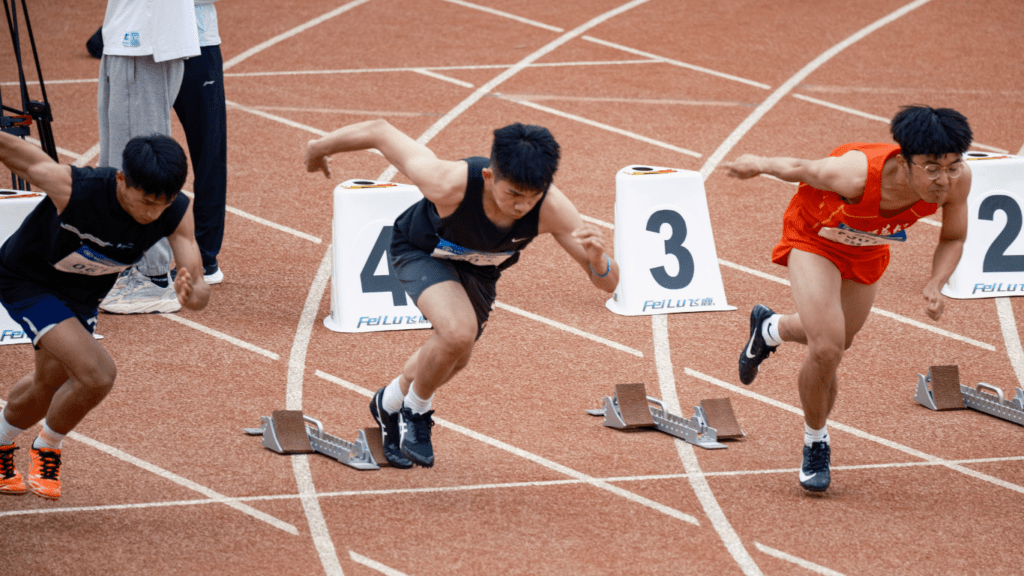Understanding Biomechanics
Biomechanics examines the structure and function of biological systems using the principles of mechanics. In athletics, it’s crucial for perfecting techniques and minimizing injury risks.
Definition and Principles
Biomechanics studies human movement to understand how forces interact with the body. This field applies mechanical laws, such as force, motion, and leverage, to analyze athletic performance. By observing these principles, I can identify how body mechanics influence the efficiency and effectiveness of specific movements, providing insights into technique improvements.
Importance in Sports
In sports, biomechanics informs training regimes by identifying optimal body movements and positions. Analyzing motion, I can pinpoint inefficiencies or strain in techniques, providing athletes, such as:
- runners
- swimmers
with data-driven recommendations to enhance performance. This understanding also aids in injury prevention, as I uncover risky postures or motions, allowing for adjustments that reduce stress on muscles and joints.
Biomechanics and Athletic Techniques
Biomechanics plays a crucial role in refining athletic techniques by offering insights into movement patterns. Through understanding the relationship between mechanical principles and human movement, athletes can enhance both their performance and injury prevention strategies.
Improving Performance
Utilizing biomechanics enables athletes to identify and correct inefficiencies in their movements. Runners, for instance, can adjust their stride length and frequency to maximize speed and minimize energy loss. In swimming, analyzing stroke mechanics allows swimmers to improve propulsion and streamline their form. By applying biomechanical insights, athletes fine-tune their techniques to achieve more effective performance outcomes.
Injury Prevention
- Biomechanics provides valuable data on how to avoid injuries by understanding body alignment and movement dynamics.
- Basketball players, for example, can use biomechanical analysis to learn proper landing techniques, reducing the risk of ankle or knee injuries.
- Football players can adjust their tackling forms to minimize impact stress.
- With biomechanics, athletes not only improve alertness to potential risk factors but also implement preventative measures to maintain long-term health and success in their sports.
Analyzing Biomechanics in Different Sports

Examining biomechanics in various sports reveals its impact on enhancing athletic techniques and preventing injuries. By understanding specific biomechanical elements, athletes can improve precision and efficiency in their movements.
Track and Field
In track and field, biomechanics plays a critical role in optimizing performance. Analyzing the sprinter’s stride length and frequency aids in maximizing speed. Mechanics of the takeoff and landing phases are crucial for long jumpers, impacting distance. For shot putters, understanding the force applied during the release can enhance throwing techniques. The analysis of these mechanical elements helps athletes refine their skills with increased accuracy, leading to improved results in competitions.
Team Sports
Biomechanics is essential in team sports, offering insights into improving coordination and movement strategies. For basketball players, analyzing shooting mechanics can lead to enhanced accuracy; motion dynamics are pivotal in optimizing dribbling and passing techniques. In soccer, examining a player’s running form and kicking mechanics aids in achieving better control and precision. By studying these movement patterns, team athletes can hone their techniques, contributing to successful plays and reduced injury rates.
Gymnastics
In gymnastics, biomechanics provides a foundation for mastering complex movements. Detailed analysis of force and motion in flips and vaults helps gymnasts execute routines with precision. Understanding balance and body position during routines ensures safety and control, particularly in high-risk poses. By leveraging biomechanical insights, gymnasts can improve their performance quality and maintain long-term health in a demanding sport.
Tools and Technologies in Biomechanics
Advancements in tools and technologies play a significant role in biomechanics, offering deeper insights into athletic performance. These innovations facilitate precise analysis and measurement of movement, enhancing technique optimization and injury prevention.
Motion Analysis
Motion analysis employs high-speed cameras and software to scrutinize athletes’ movements. Capturing detailed motion data allows me to break down complex techniques, revealing inefficiencies and areas for improvement. Coaches use this data to refine athletic strategies, ensuring athletes achieve optimal motion patterns. By analyzing variables like joint angles and velocities, motion analysis provides a comprehensive understanding of how movements impact performance.
Wearable Sensors
Wearable sensors monitor biomechanics in real-time, offering valuable data on performance metrics such as acceleration and force. These devices, integrated into athletic apparel or accessories, measure an athlete’s movements throughout training or competition. By collecting and analyzing this data, I can assess factors like balance and power output, allowing for personalized feedback and adjustments. Wearable technology enhances training programs by identifying specific biomechanical challenges and supporting injury prevention strategies.
